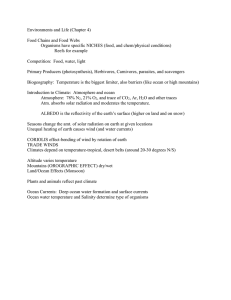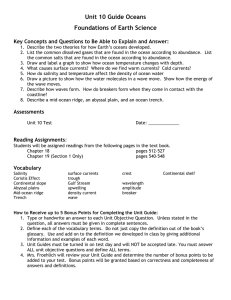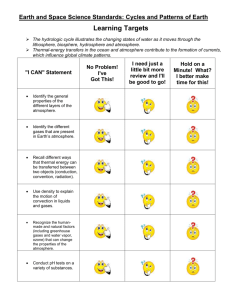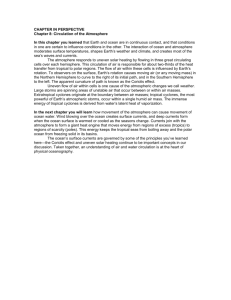Mid-Term Study Guide Name: Blessing, Cashman, Harris, Touve
advertisement
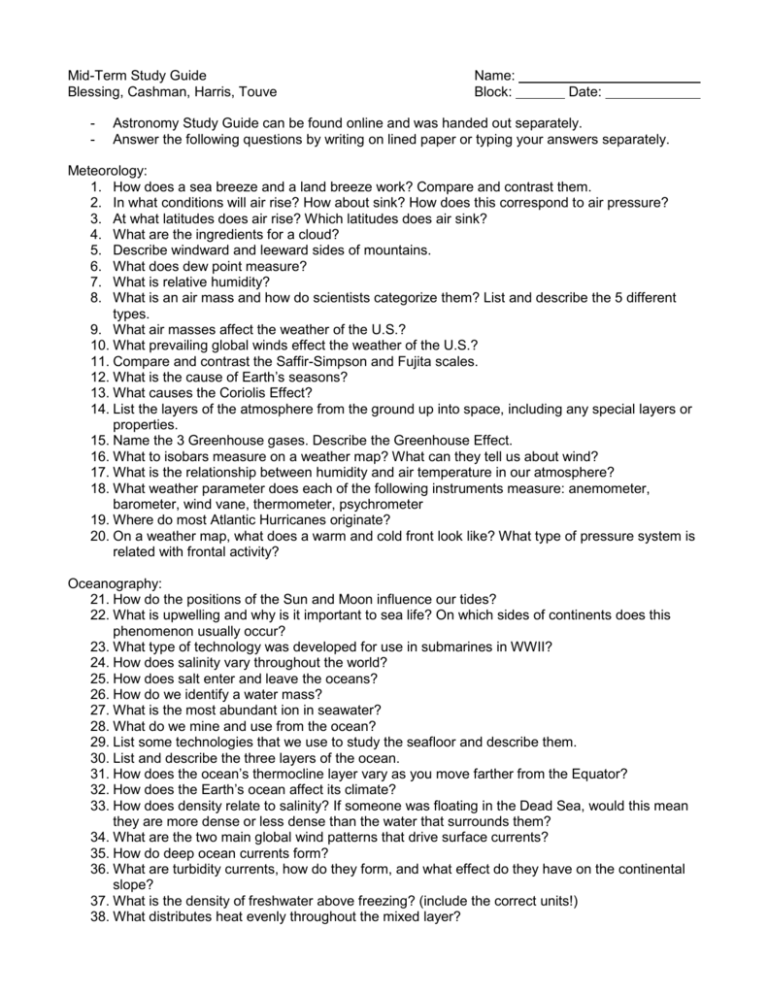
Mid-Term Study Guide Blessing, Cashman, Harris, Touve - Name: Block: Date: Astronomy Study Guide can be found online and was handed out separately. Answer the following questions by writing on lined paper or typing your answers separately. Meteorology: 1. How does a sea breeze and a land breeze work? Compare and contrast them. 2. In what conditions will air rise? How about sink? How does this correspond to air pressure? 3. At what latitudes does air rise? Which latitudes does air sink? 4. What are the ingredients for a cloud? 5. Describe windward and leeward sides of mountains. 6. What does dew point measure? 7. What is relative humidity? 8. What is an air mass and how do scientists categorize them? List and describe the 5 different types. 9. What air masses affect the weather of the U.S.? 10. What prevailing global winds effect the weather of the U.S.? 11. Compare and contrast the Saffir-Simpson and Fujita scales. 12. What is the cause of Earth’s seasons? 13. What causes the Coriolis Effect? 14. List the layers of the atmosphere from the ground up into space, including any special layers or properties. 15. Name the 3 Greenhouse gases. Describe the Greenhouse Effect. 16. What to isobars measure on a weather map? What can they tell us about wind? 17. What is the relationship between humidity and air temperature in our atmosphere? 18. What weather parameter does each of the following instruments measure: anemometer, barometer, wind vane, thermometer, psychrometer 19. Where do most Atlantic Hurricanes originate? 20. On a weather map, what does a warm and cold front look like? What type of pressure system is related with frontal activity? Oceanography: 21. How do the positions of the Sun and Moon influence our tides? 22. What is upwelling and why is it important to sea life? On which sides of continents does this phenomenon usually occur? 23. What type of technology was developed for use in submarines in WWII? 24. How does salinity vary throughout the world? 25. How does salt enter and leave the oceans? 26. How do we identify a water mass? 27. What is the most abundant ion in seawater? 28. What do we mine and use from the ocean? 29. List some technologies that we use to study the seafloor and describe them. 30. List and describe the three layers of the ocean. 31. How does the ocean’s thermocline layer vary as you move farther from the Equator? 32. How does the Earth’s ocean affect its climate? 33. How does density relate to salinity? If someone was floating in the Dead Sea, would this mean they are more dense or less dense than the water that surrounds them? 34. What are the two main global wind patterns that drive surface currents? 35. How do deep ocean currents form? 36. What are turbidity currents, how do they form, and what effect do they have on the continental slope? 37. What is the density of freshwater above freezing? (include the correct units!) 38. What distributes heat evenly throughout the mixed layer? 39. Give an example of a nekton. 40. What is the primary source of energy for organisms in the mixed layer? The Deep Zone (near hydrothermal vents)? 41. What is a reason that a city on the Equator could have a cold climate? 42. How do we characterize a regions climate? 43. Why should vegetation on sand dunes be left alone? (What benefit do they have to the dunes?) 44. What causes ocean waves? Possible Short Answer questions (for all units): 1. 2. 3. 4. 5. Know the different parts of experimental design and how to pick them out of a scenario. Know how to plot latitude and longitude as well as name the Earth’s oceans. How does insolation vary with your location on the Earth? Explain how convection heats our atmosphere. Use density in your explanation. On a weather map, be able to label a cold front, warm front, circle a city with sunny skies, and draw where the high and low pressure systems are. 6. Be able to label features of the seafloor, given a diagram. 7. Given the H-R Diagram, be able to label which regions are different types of stars and which stars are hotter than others. 8. Why do scientists study the emission spectrums of stars? 9. Compare and contrast the life cycle of our Sun and a massive star. 10. Be able to draw which way a comet’s tail will flow relative to the Sun.

